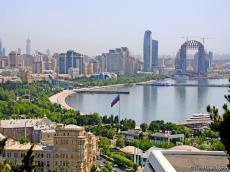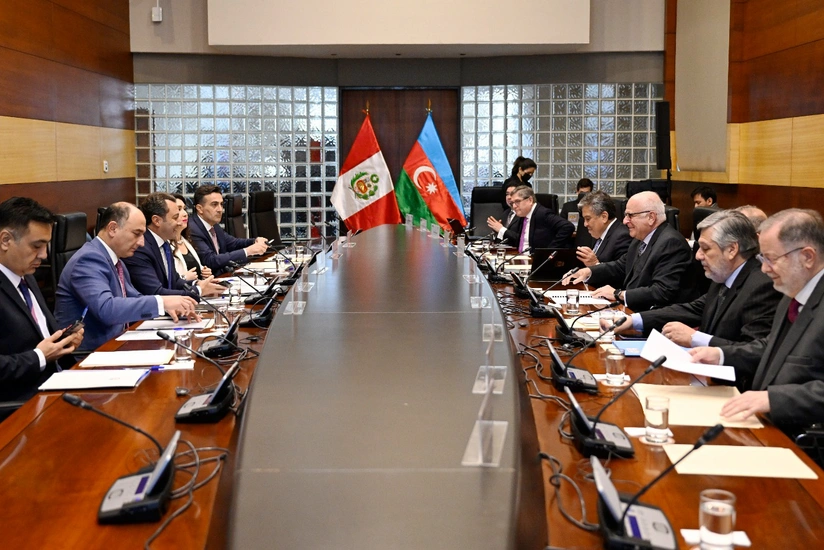|
|
TODAY.AZ / Business
Economic policy aimed at victory and development in Azerbaijan during 10 years
31 July 2021 [12:15] - TODAY.AZ

By Asif Mehman - Trend:
The long-term development prospects of each country depend on its sound and reliable foundation. It is impossible to achieve the radical change in the socio-economic life of the country without the precise definition of goals and objectives, spheres of development in the medium and long terms, without the development of action programs in various spheres.
Economic policy pursued by Azerbaijani President Ilham Aliyev for the past 10 years has strengthened the foundation of Azerbaijan. The period of leadership from 2010 through 2020 was very fruitful in terms of strengthening and developing the Azerbaijani economy.
Over the years, strong Azerbaijani economy has formed with a 60 percent share in the economy of the South Caucasus. GDP per capita increased from 4.753 manat ($2.795) to 7.263 manat ($4.272).
Production in the non-oil sector increased by almost 1.6 times while in agriculture it increased from 3.9 billion manat ($2.3 billion) to 8.4 billion manat ($4.9 billion). The share of the non-oil sector in export was increased from 7.4 percent to 13.7 percent.
The state budget revenues increased by 2.1 times, amounting to 24.7 billion manat ($14.5 billion). The real volume of income of the population increased by 1.3 times while per capita income doubled. Presently, per capita income is 5,587.6 manat ($3,286.8), while in 2010 this figure was 2.866 manat ($1.685).
Today, the nominal average monthly wage in Azerbaijan has grown by 2.1 times from 331.5 manat ($195) to 707.3 manat ($416.05). In accordance with this indicator, Azerbaijan ranks first in the CIS. The nominal amount of the average monthly pension increased by 2.7 times from 112.9 manat ($66.4) to 302.2 manat ($177.8).
These indicators of economic development allowed Azerbaijan to climb several steps in various international ratings. Presently, in accordance with the Doing Business report, Azerbaijan ranks 28th among 191 countries and is among the ten most reforming countries in the world.
Over the years, great development has been achieved in the energy sector, industry, agriculture, transport, information, communications and high technologies, tourism, finance, construction and banking sectors.
Energy sector development indicators and achieved progress:
- an increase of 27.6 percent has been achieved in electricity production over the past 10 years. So, electricity production increased by 7,134.6 million kW in 2020 compared to 2010, amounting to 25,811.2 million kW;
- the country has become an exporter of electricity while the export of these products has tripled from 380 million kW to 1,150.7 million kW;
- the stability of work has been increased in the electric power industry, its technological base has been strengthened and the infrastructure has been improved;
- production has been modernized for the prospective support of oil and gas production;
- the EU and Azerbaijan signed a joint declaration in 2011 supporting the creation of routes transporting gas from the Caspian Sea directly to Europe;
- the export of the produced natural gas was ensured initially to Turkey and Southern Europe via the South Caucasus gas pipeline, TANAP and TAP;
- an infrastructure for alternative and renewable energy sources has been created for the rational use of energy resources and increasing energy efficiency, cooperation in this sphere with the private sector has been expanded;
- a Memorandum of Understanding was signed with Turkmenistan on joint exploration, development of hydrocarbon resources of the Dostlug field.
Industrial reforms and development indicators:
- presently, over 1/2 of the country's GDP, including more than 1/ 4 of non-oil products, is produced in industrial sectors;
- the industry has entered a new stage of development, 2014 was declared the "Year of Industry" in Azerbaijan;
- The State Program for the Development of Industry in Azerbaijan for 2015-2020 has been developed;
- despite the COVID-19 pandemic and external influence, high growth rates were stressed in the non-oil industry (12.5 percent in 2020);
- the structure of industrial sites has been modernized and improved, competitive innovative production has been expanded;
- diversification of production in industry was expanded, competitive industrial parks and industrial zones based on modern technologies began to operate;
- the volume of production in industrial zones (parks and zones) amounted to 1.3 billion manat ($764 million) while 55 percent of the products were exported in 2020;
- 35 out of 50 enterprises with resident status began to operate in industrial parks, more than six billion manat ($3.5 billion) were invested and over 9,000 new jobs were created till 2020;
- some 17 out of 30 enterprises with the status of a participant began to operate in industrial zones, so far 73 million manat ($42.9 million) have been invested and over 280 jobs have been created;
- the space industry has been developed, the state program for the development of services for remote observation of the Earth surface through satellites for 2019-2022 has been developed, the export of orbital services has begun;
- new competitive enterprises were established in the field of mechanical engineering, production of equipment and building materials, instrument making, which form the main components of the non-oil industry, including the enterprises for the production of tractors and agricultural machinery in Ganja, cars in Nakhchivan, electronic equipment in Mingachevir, solar panels in Sumgayit, metal structures in Garadagh, ceramic tiles in Hajigabul;
- new enterprises operating in the textile sector, in the production of clothing, leather goods and footwear, paper and cardboard, furniture and other spheres of the non-oil processing industry were built and commissioned in Baku and the Azerbaijani districts;
- about 50 new production sites were built to create the strong defense industry, along with military products, the production of civilian products was organized;
- a sugar production plant in Imishli, a salt production plant in Absheron, a plant for the production of vegetable oils in Sumgayit, a complex for the processing of corn and the production of glucose sugar in Oguz, dairy plants in various districts, canneries and other enterprises were put into operation in the field of food production;
- the Alat free economic zone began to operate.
Work carried out in the agricultural sector:
- on average, up to 1/5 of the added value in the non-oil sector over the past 10 years has been produced in agriculture;
- the state attention to the agricultural sector has been increased, the financing mechanism has been improved, agricultural insurance has been developed and a system of incentives has been formed to attract investments;
- the management system in the agrarian sector has been improved, the access to environmentally friendly and high-quality agricultural products and services has been expanded;
- the level of provision with agricultural equipment has been improved, institutional reforms have been carried out to increase accessibility;
- the intensive introduction of modern technologies in the leading spheres of agriculture has been achieved, the growth of yield and export has become a trend;
- an increase in the level of self-sufficiency for most of the agricultural and food products was ensured;
- information bases on the agrarian sector have been created, work on the electronization of agriculture has begun;
- the development of the agricultural processing industry and logistics infrastructure was ensured;
- reforms were carried out in the field of quality control and food safety.
Key indicators and success in the tourism sector:
- over the past 10 years (not taking into account the period of the COVID-19 pandemic), the tourism sector has grown by 3.3 times, the country's potential in this sphere has greatly improved;
- the number of foreign citizens who visited the country increased from 1.9 million people to 3.2 million people, the number of people accommodated in hotels increased by more than 4.5 times, reaching two million people;
- the tourism management system was improved to form and promote the tourism brand of Azerbaijan, enhance competitiveness in the global market;
- the legislation in the field of tourism has been improved, new tourist routes have been created, the spheres of business and cultural tourism have been developed;
- the numerous information centers covering the districts to popularize the country's tourism opportunities and implement infrastructure projects were created;
- large-scale propaganda and marketing work was carried out, tax free and e-Visa systems were introduced, tourist offices opened in six countries to promote the tourism potential at the international level;
- various tourist facilities, including new hotels and hotel-type enterprises, were commissioned.
Despite the hard consequences of the COVID-19 pandemic on the global economy last year, the Azerbaijani economy has been growing. Moreover, Azerbaijan has applied a successful model in the fight against the COVID-19 pandemic.
The country has taken large-scale measures to combat the COVID-19 pandemic:
- comprehensive measures have been prepared to prevent the negative impact of infection on the socio-economic life of the country;
- A Fund to Support the Fight Against Coronavirus was created, for these purposes, 20 million manat ($11.8 million) were initially allocated from the reserve fund of the president of Azerbaijan, 113.8 million manat ($66.9 million) have been collected, of which 7.4 million manat ($4.3 million) were donated by the citizens of the country;
- the plan of measures to reduce the negative impact of the COVID-19 pandemic was approved (the plan envisages urgent measures to support the affected spheres, strengthen social protection of the population and transition to a new model of economic growth in the post-COVID-19 pandemic period);
Some 610 million manat ($358.8 million) were spent to support employment and social well-being, 754.2 million manat ($443.6 million) were spent on healthcare measures, 1.1 billion manat ($647 million) were spent on supporting economic growth and entrepreneurship, 1.5 billion manat ($882 million) – credit portfolio, 39.3 million manat ($23.1 million) - to support large-scale measures within the fight against COVID-19.
URL: http://www.today.az/news/business/208480.html
 Print version
Print version
Connect with us. Get latest news and updates.
See Also
- 06 September 2025 [15:25]
Azerbaijan, Hungary hold business forum in Budapest - 06 September 2025 [08:30]
Cyber intrusions in S Caucasus: Azerbaijan at frontline of hybrid conflict [ANALYSIS] - 05 September 2025 [15:25]
New Service Center opens in Icherisheher to streamline public services for residents - 05 September 2025 [14:56]
Azerbaijan railways completes major AC electrification upgrade on Ujar–Hajigabul section - 05 September 2025 [13:55]
Azerbaijani delegation meets with ICAO leadership in Bern to expand aviation cooperation - 05 September 2025 [12:22]
Deputy Head of Cybersecurity Service warns emerging threats in Azerbaijan's public sector - 05 September 2025 [10:23]
Icherisheher reserve strengthens IT infrastructure via G-Cloud Migration - 04 September 2025 [15:57]
Azerbaijan, Brazil explore cooperation in energy and mining - 04 September 2025 [14:16]
New phase of repairs begins in Khojavend - 04 September 2025 [13:38]
Azerbaijan advances renewable energy with largest battery storage system in region
Most Popular
 The topic of "prisoners" is closed, but... - how revanchists mourn the ICRC
The topic of "prisoners" is closed, but... - how revanchists mourn the ICRC
 Azerbaijan, Peru hold first round of political consultations in Lima
Azerbaijan, Peru hold first round of political consultations in Lima
 Azerbaijan, Türkiye deepen energy cooperation in ?zmir
Azerbaijan, Türkiye deepen energy cooperation in ?zmir
 Azerbaijan, Brazil explore cooperation in energy and mining
Azerbaijan, Brazil explore cooperation in energy and mining
 Madat Babayan names Armenian officers in court linked to atrocities in Khojaly Genocide
Madat Babayan names Armenian officers in court linked to atrocities in Khojaly Genocide
 Who is the Russian Foreign Ministry trying to deceive? About "payments" due to the AZAL plane crash
Who is the Russian Foreign Ministry trying to deceive? About "payments" due to the AZAL plane crash
 Accused in Khojaly case recounts atrocities in preliminary investigation
Accused in Khojaly case recounts atrocities in preliminary investigation
